Introduction: Why Knowledge Gaps Are Inevitable
No chatbot knows everything, even with cutting-edge technology like generative AI (GenAI). The reasons lie in the nature of things. Language is complex, information is constantly changing, and people often communicate with unspoken assumptions. What is correct today can be outdated tomorrow.
Users also constantly ask new questions, bring individual experiences and cultural backgrounds, and expect their counterparts to read between the lines.
AI can do a lot, but these subtle nuances are often difficult to grasp.
This is why knowledge gaps (also called intent gaps) arise, such as a missing detail in a product description, an unclear answer from support, or outdated information. Typical examples are:
- Changed opening hours during vacation or holidays
- Adjusted prices or packages that have not yet been updated in the chatbot
- Extended shipping times (e.g., due to supply bottlenecks) while the chatbot continues to state the standard delivery
Such gaps are part of everyday life. Those who identify and specifically close these gaps in their own chatbot not only ensure more satisfied users but also measurably increase conversions.
Then vs. Now: From Intent Gaps to Knowledge Gaps
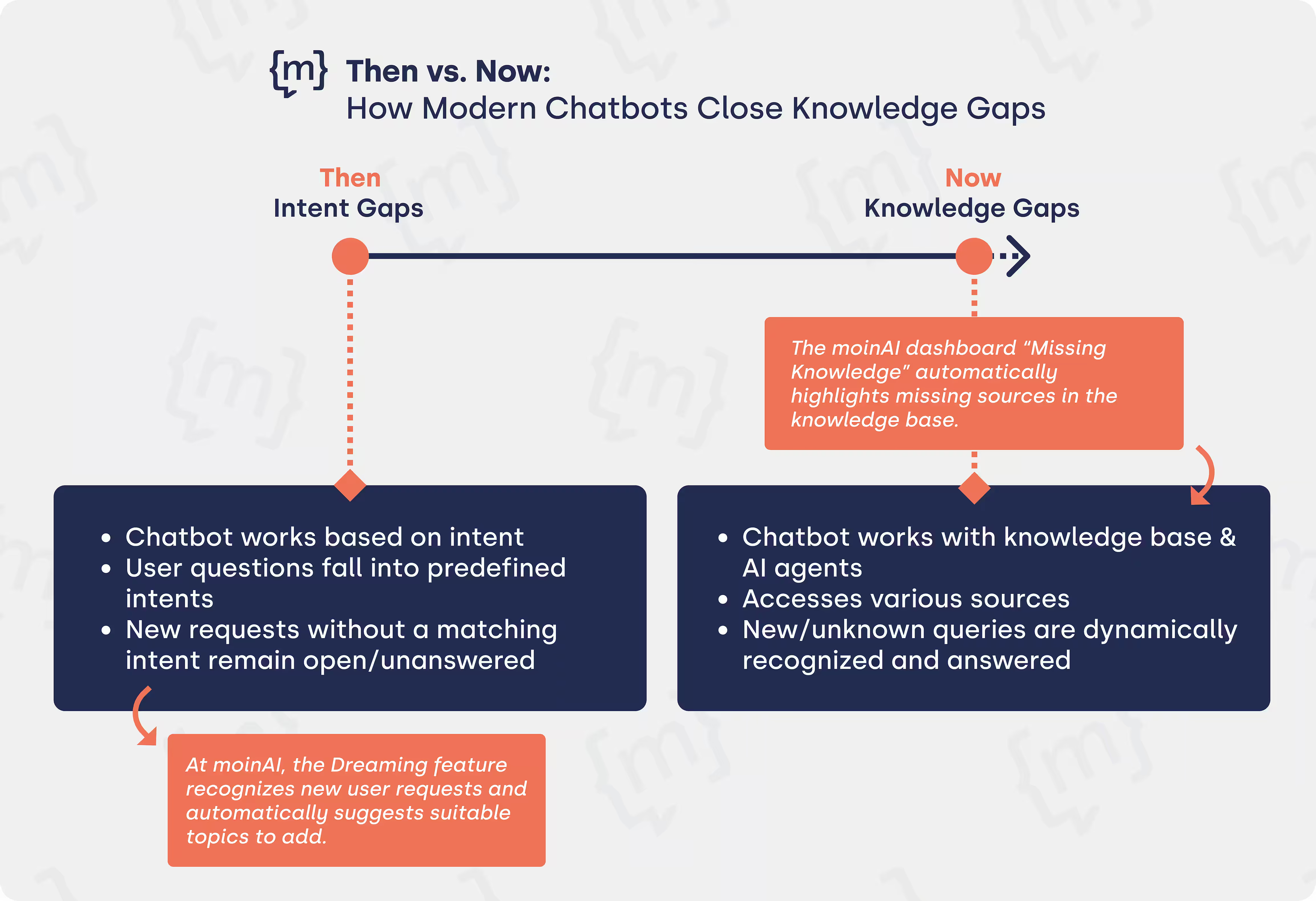
Chatbots used to work primarily on an intent-based basis. An intent is the purpose or goal a user pursues with their query. For example, someone wants to know how to change their password. That is an intent. Here we explain everything you need to know about chatbot intents in detail.
You can imagine an intent as a separate ‘room’ into which all queries with the same goal fall. All questions about password changes therefore end up in this room. There are numerous questions that can be assigned to a single intent. For example, someone who wants to change their password could formulate the query like this:
- ‘I forgot my password’
- ‘I can't log in anymore because I don't remember my login details’
- ‘I can't remember my password’
- ‘I need help resetting it; I don't know my login information anymore’
The AI's job is also to correctly assign all these different formulations to the appropriate intent. Even if synonyms, typos, or new word choices are used, the AI recognizes what they are about.
But sometimes a query arises for which there is no existing intent, for example:
User: ‘When does the new branch open?’
If the chatbot does not yet know about this, it cannot provide a suitable answer. So, even though the AI can understand a wide range of phrases and assign them to the correct intent, there are still cases where the AI can't find a suitable intent for a query. Simply because it doesn't exist yet.
At moinAI, the Dreaming feature helps identify these completely new and previously unknown phrases. When the chatbot receives a query that can't be assigned to an existing topic, the Dreaming feature analyzes it. It groups similar, recurring queries and automatically and independently suggests creating new, relevant topics.
This provides precise insights into the actual needs of users, and blind spots in the knowledge base can be more easily avoided.
With GenAI the focus shifts
With the advent of GenAI, however, the focus of chatbot use has shifted. Today, AI agents (also called AI agents) are increasingly being used. Unlike topics, these do not provide fixed, editorially maintained answers, but generate dynamic, AI-supported answers, usually based on a central knowledge base.
Topics and agents are both based on the recognition of user intents, but differ in how they provide knowledge and respond:
- Topics provide fixed, editorially maintained answers, similar to an FAQ.
- Agents are more flexible and can respond to different formulations. They are used to handle more complex user queries and can draw on various resources within the knowledge base (e.g., stored web pages, PDF or CSV documents, text documents, or question-answer pairs).
While topics continue to operate primarily intent-based, modern agents increasingly rely on knowledge base resources to correctly answer even unknown or unusual queries.
There are usually three different types of agents in use today:
- The standard AI agent answers general queries that aren't assigned to an existing intent and creates a suitable answer based on the knowledge base.
- Specialized agents support specific processes, such as reporting meter readings or terminating a contract.
- AI product advisors are focused on sales and can assist with purchasing decisions, e.g., through product searches or tariff recommendations.
This also shifts the nature of the knowledge gap in the chatbot. Previously, it was primarily about intent gaps, i.e., correctly recognizing the user's intent and identifying missing topics. Today, larger knowledge gaps arise, known as knowledge base gaps. If the appropriate source is missing, the chatbot cannot provide a complete answer, no matter how well it understood the question.
In the moinAI Hub, such gaps appear under ‘Missing Knowledge’.
Functions like dreaming therefore only play a supporting role today. The focus is on continuously expanding and maintaining the knowledge base so that AI agents can respond precisely to new or unusual requests. We summarized here how the knowledge database should be structured and why it is so important for the use of AI.
Identifying knowledge gaps: How do I find out what my chatbot knows (or doesn't know)?
Operating a chatbot is one thing. But continuously improving it is quite another. At some point, a simple "I'm sorry, I can't answer that" is simply no longer enough. moinAI therefore offers three practical ways to detect precisely these knowledge gaps:
1. The ‘Missing Knowledge’ Dashboard
The easiest way to identify knowledge gaps leads directly to the backend. moinAI offers a ‘missing knowledge’ area, which collects all queries where the chatbot is unsure or stalls. If, for example, questions about shipping times or return policies repeatedly appear there, it quickly becomes clear that the chatbot lacks the appropriate source. If this source is supplemented, for example, with a document, the AI can access it directly and provide reliable answers.
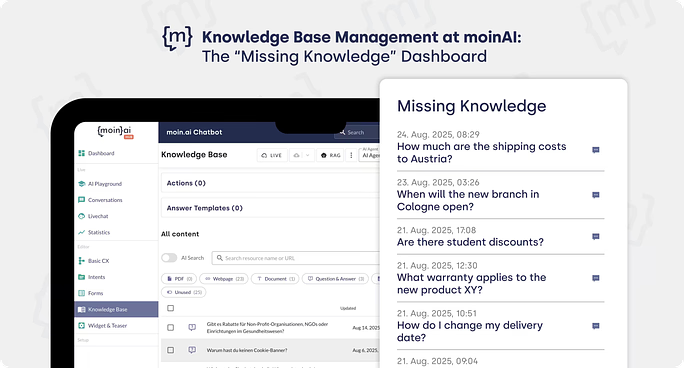
2. AI-supported suggestions (Dreaming feature)
The AI itself can also uncover knowledge gaps – at moinAI, this happens via the Dreaming feature. Based on frequently asked user questions, the AI suggests which content should be added. For example, if many customers ask about a specific product feature that the bot isn't yet familiar with, the AI notices this immediately and provides new topic suggestions.
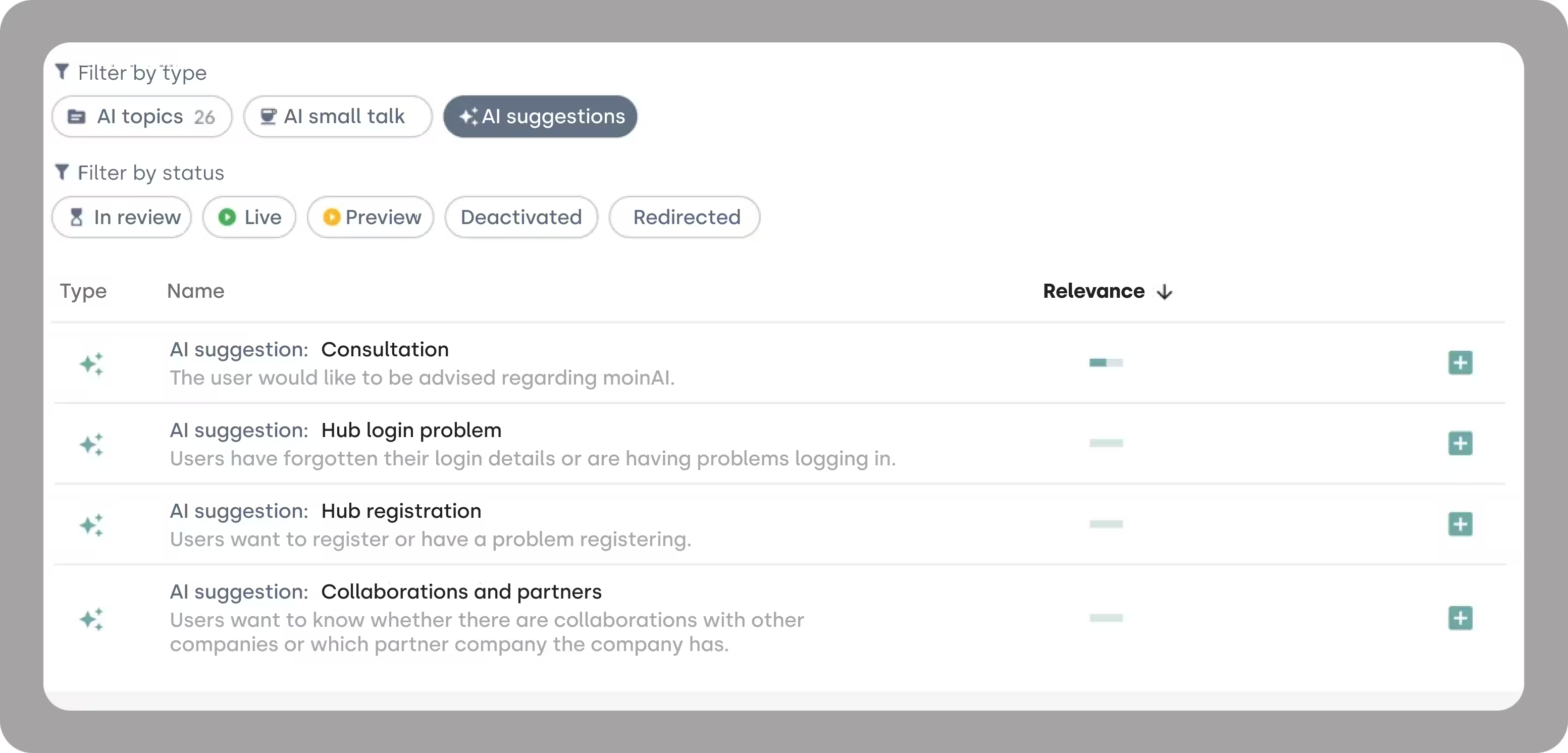
3. Evaluating User Feedback
User feedback is also worth its weight in gold. A thumbs down, a bad rating, or a brief comment like ‘That doesn't help me’ are signals that the chatbot still has room for improvement or that user expectations haven't been met. These signals are automatically pooled and evaluated in moinAI's Insights section. This immediately shows where new answers or precise explanations are needed.
A good example of this is Teleboy. User feedback was analyzed in detail, and the insights gained helped to specifically improve the chatbot.
→ Click here for the Teleboy case study for more information.
Together with the ‘Missing Knowledge’ dashboard and the AI suggestions, this creates a cycle that closes knowledge gaps step by step. This, of course, increases user satisfaction in the long term and ensures that the chatbot becomes more and more accurate over time.
Closing Knowledge Gaps: How I Improve My Chatbot
A chatbot is only as good as the knowledge it can access. To provide reliable answers, content must be kept up-to-date and missing information must be added. With moinAI, these knowledge gaps can not only be made visible but also closed in a structured manner. Four key steps help to continuously optimize the chatbot and noticeably improve its quality.
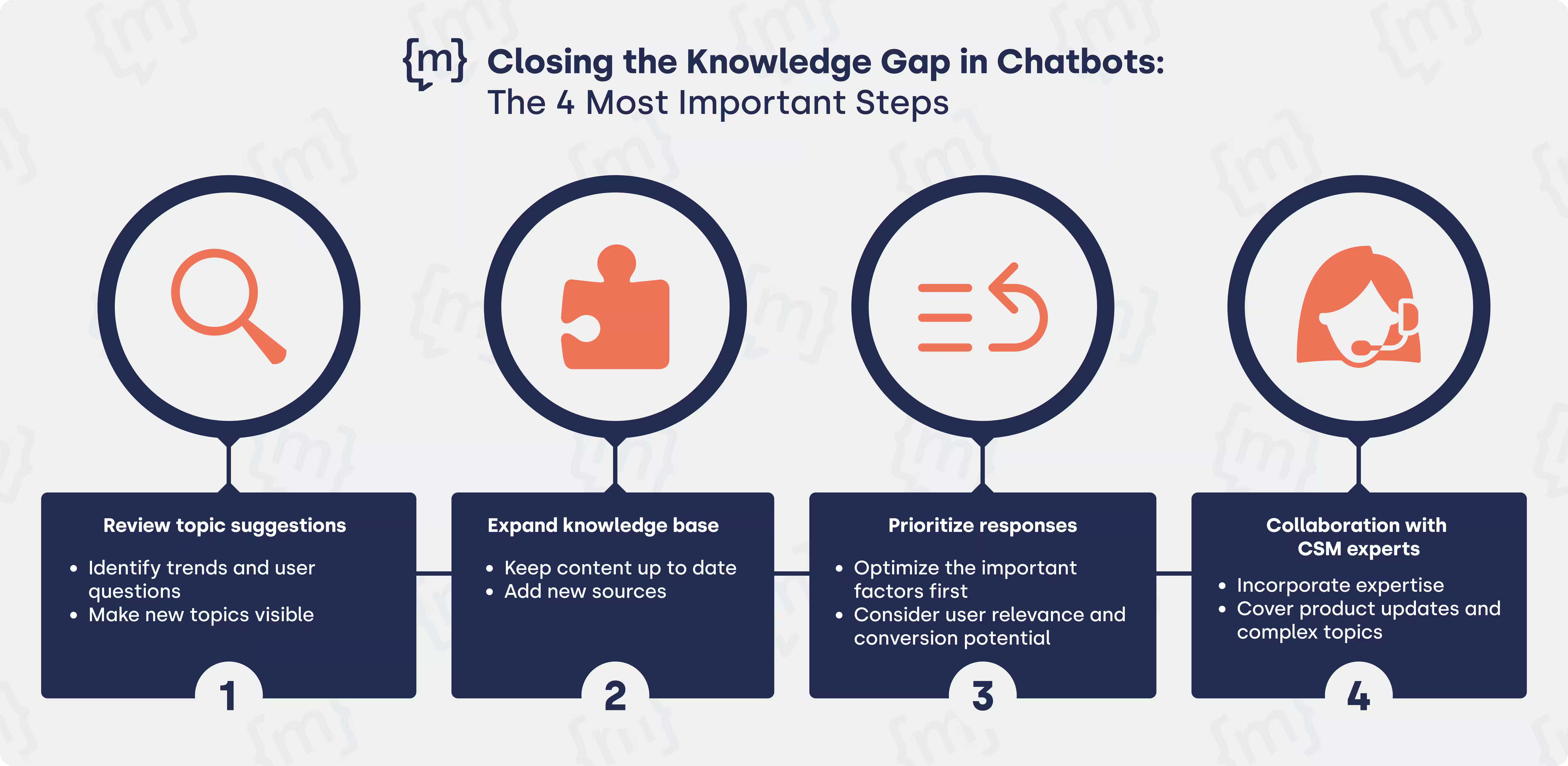
1. Regularly Review Topic Suggestions
As already mentioned, moinAI automatically creates topic suggestions that show which questions users are currently asking most frequently or which content is trending. Therefore, if you regularly review these suggestions, you can identify new topics early on and prepare the chatbot specifically for them. This creates proactive knowledge building. The chatbot has answers ready before the questions even arise. At the same time, the suggestions can be used to identify knowledge gaps.
2. Targetedly Expand the Knowledge Base
The knowledge base is the foundation of all answers in the chatbot. At moinAI, existing content is regularly crawled automatically. New information is thus added directly to the system without having to be manually entered. When completely new pages such as landing pages, product information, or external sources are added, a single addition is sufficient. This way, the knowledge base grows continuously. The bot not only accurately reproduces current content but also unlocks new knowledge step by step.
3. Prioritize answers
Not all questions are equally important. Therefore, moinAI offers the option of prioritizing answers based on user relevance and conversion potential. Frequently asked questions are given priority so that the chatbot can answer them particularly quickly and reliably. In addition, the analytics functions can be used to identify and specifically optimize topics with high conversion potential. This prioritization ensures that the chatbot offers the greatest benefit.
4. Collaboration with the CSM team / internal experts
A chatbot thrives not only on technology, but also on the knowledge of the people behind it. Regular communication with moinAI CSM experts and internal specialists ensures that product updates, new insights, or particularly complex topics are reliably incorporated into the chatbot. This combination of technical foundation and professional expertise ensures practical optimizations and keeps the bot precise and trustworthy in the long term.
To see our team and story behind moinAI click here.
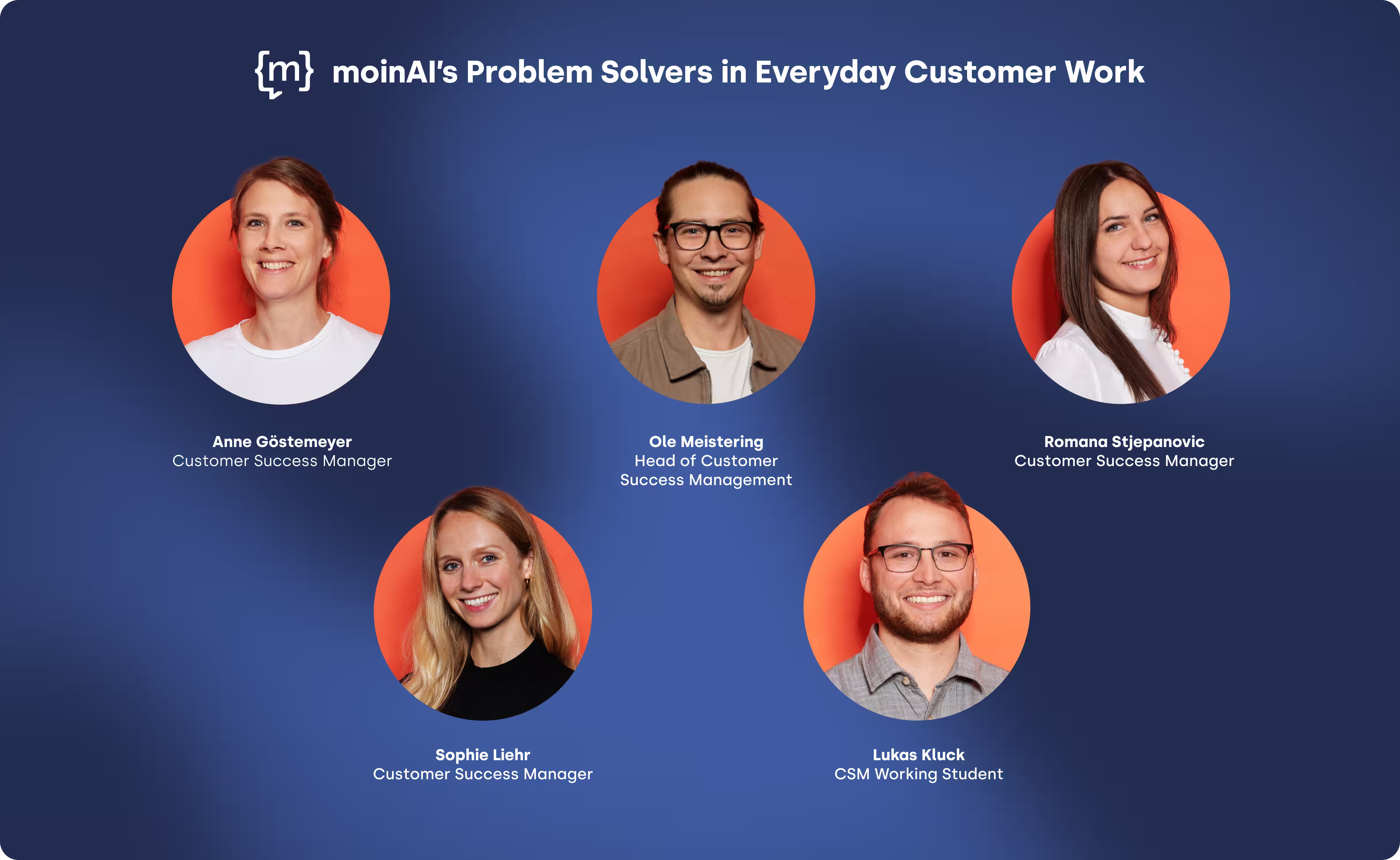
What happens if nothing happens?
Even if the standard AI agent can answer many queries correctly, it's not enough to simply let the chatbot run. Without proactive optimization, knowledge gaps will remain, and users will sooner or later encounter answers that seem incomplete or unclear.
Continuous optimization, on the other hand, ensures that the chatbot responds faster and more relevantly. This noticeably improves the user experience, increases the hit rate, and thus also increases the likelihood that desired actions such as purchases or registrations will be completed.
At the same time, a well-maintained chatbot reduces unnecessary queries, relieves the support team, and makes the entire service more efficient.
And that's exactly what it's all about: the chatbot should provide answers that really fit.
Conclusion: Gaps Are Normal – but Not Unimportant
Knowledge gaps are part of a chatbot's everyday life. The key is to actively identify and close them. With moinAI, the bot can be continuously improved: Analysis tools show where further training is needed, the knowledge base is regularly updated, and the CSM team provides support with tricky questions. This keeps your chatbot precise, helpful, and always up to date.




.svg)

.svg)



